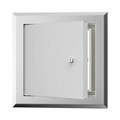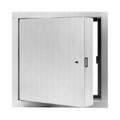Enhancing Safety and Efficiency in Construction With Insulated Access Doors: A Comprehensive Guide
In construction, professionals often face challenges like tight deadlines and limited access to crucial systems, such as electrical panels, leading to inefficiencies. Insulated access doors offer a solution, providing safe and easy access to essential systems like plumbing and HVAC. These doors enhance safety by upgrading building integrity and promoting energy efficiency by preventing heat loss and air leaks—lowering operational costs.
Structural Safety: Ensuring Stability
Structural safety in construction involves every element, including access doors. Carefully selected and installed insulated access doors help preserve the building’s outer layer, reducing weak points that could compromise structural and fire resistance.
The choice of materials further reinforces this role. Using durable options like steel strengthens access points, helping them withstand environmental and structural pressures. This becomes especially important in load-bearing walls, where access doors must carry weight without compromising performance. Reinforced frames and secure fastening systems ensure these doors contribute to the wall’s overall stability.

https://accessdoorscanada.ca/
Equally important is compliance with safety regulations and building codes. Standards from the International Building Code (IBC) and the National Fire Protection Association (NFPA) provide essential guidance. IBC Section 716, for instance, outlines requirements for fire-rated access doors, including fire resistance testing.
Meeting these standards starts with proper selection but hinges on precise installation, which is critical for passing inspections and achieving compliance.
To ensure structural safety, look for insulated access doors with:
- Certified Fire Ratings: Approved by UL or FM for fire resistance.
- Reinforced Frames: Strong steel or reinforced materials to support structural loads.
- Intumescent Seals: Seals that expand under heat to prevent fire spread.
- Robust Fastening Systems: Secure fasteners to hold the door in place.
Energy Efficiency: Saving Resources
Energy efficiency plays a major role in modern construction, and insulated access doors help support that effort. These doors act as a barrier against heat transfer—through conduction, convection, and radiation—helping maintain indoor temperatures and easing the strain on HVAC systems.
To gauge how well insulation works, builders refer to R-values, which reflect a material’s resistance to heat flow. Materials commonly used in access doors each bring their own strengths. Rigid foam is a go-to option for its reliable, reasonably priced performance. Mineral wool adds the bonus of fire resistance and sound dampening.
Spray foam creates a strong air seal, making it effective for tight insulation, while extruded polystyrene stands out for its water resistance, though it raises some environmental considerations during manufacturing.
Insulated doors also help reduce air leaks and thermal bridging—areas where heat can sneak in or out. By sealing those off, buildings use energy more efficiently. This leads to better performance from heating and cooling systems, often reflected in metrics like energy efficiency ratios for heating and cooling.
Applications affect considerations:
- HVAC Access: Minimizes air leaks and keeps duct insulation.
- Attic Access: Reduces heat loss to unconditioned areas.
- Plumbing Access: Stabilizes water temperature and reduces heating energy.
To evaluate financial impact:
- Annual Energy Savings = (Reduction in Heating/Cooling Load) × (Energy Cost per Unit)
- Payback Period = (Initial Cost + Installation) / (Annual Energy Savings)
Regular maintenance is vital for long-term efficiency. Inspect for air leaks, check insulation integrity, and ensure proper function of latches and seals. A proactive approach helps insulated access doors save energy throughout their lifespan.
Material Matters: Choosing Wisely
Safety and efficiency are key factors when choosing materials for insulated access doors.
- Steel is strong and fire-resistant but can rust if not treated properly.
- Aluminum is lightweight and resists corrosion but is usually less fire-resistant than steel.
- Fiberglass is moisture-resistant and provides good insulation, though it may not be as strong as the other materials.
Ultimately, the right material depends on the access doors’ specific use and environmental conditions.

https://accessdoorscanada.ca/
Installation: Getting It Right
Proper installation is key to getting the best results. Follow these important steps for a successful process:
- Align Framing: It is essential to accurately position and line up all framing components to keep structural integrity.
- Seal Gaps: Focus on sealing gaps to prevent air and water leaks, affecting insulation and efficiency.
- Use Fasteners: Select proper fasteners to securely attach all parts, ensuring durability and stability in the construction.
- Check Level: Regularly verify that everything is balanced and level to ensure proper functionality and minimize future issues.
Be aware of common mistakes, like using the wrong sizes for materials and not sealing properly. Always follow safety guidelines and use the recommended tools to improve safety and efficiency.
Maintenance and Longevity: Ensuring Performance
Routine maintenance is important for keeping equipment and materials working well over time. This involves regularly checking, cleaning, and fixing items as needed. Overlooking routine maintenance may result in safety concerns and decreased efficiency.
Investing in Quality
Insulated access doors are a valuable investment in safety, efficiency, and sustainability. They contribute to safer, more energy-efficient, and durable buildings. Consulting with specialists ensures proper selection and installation, leading to long-term benefits and reduced environmental impact.

